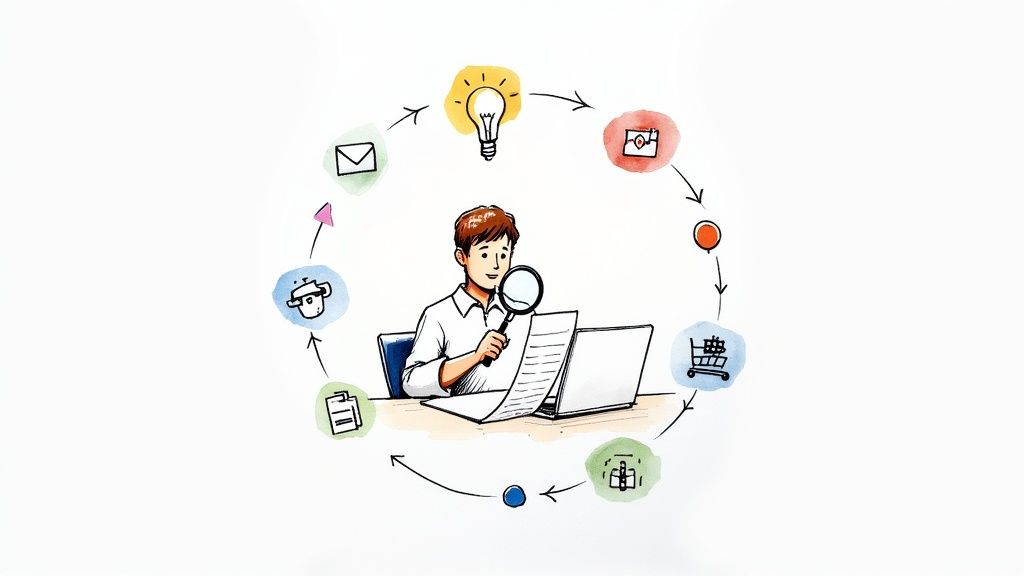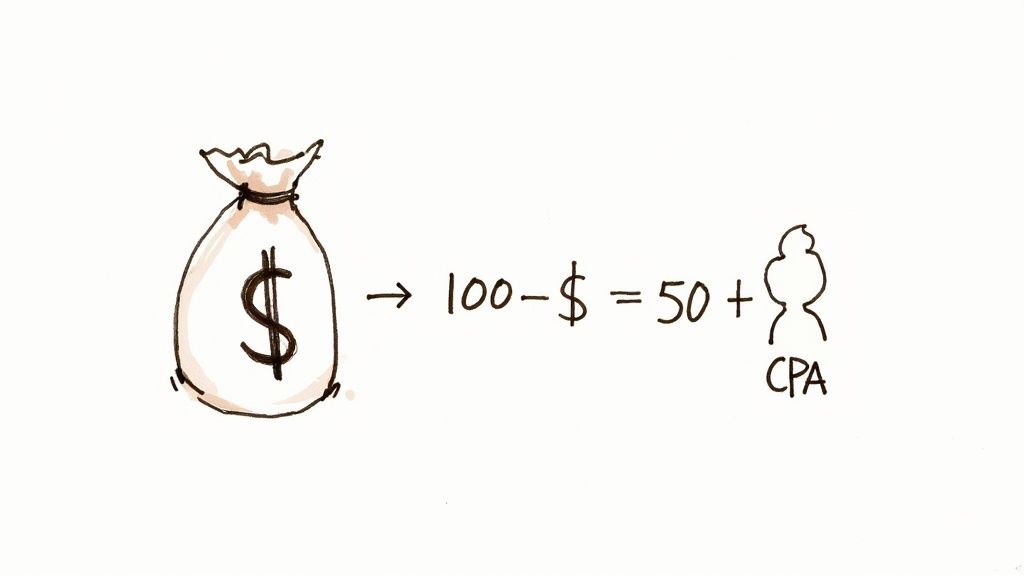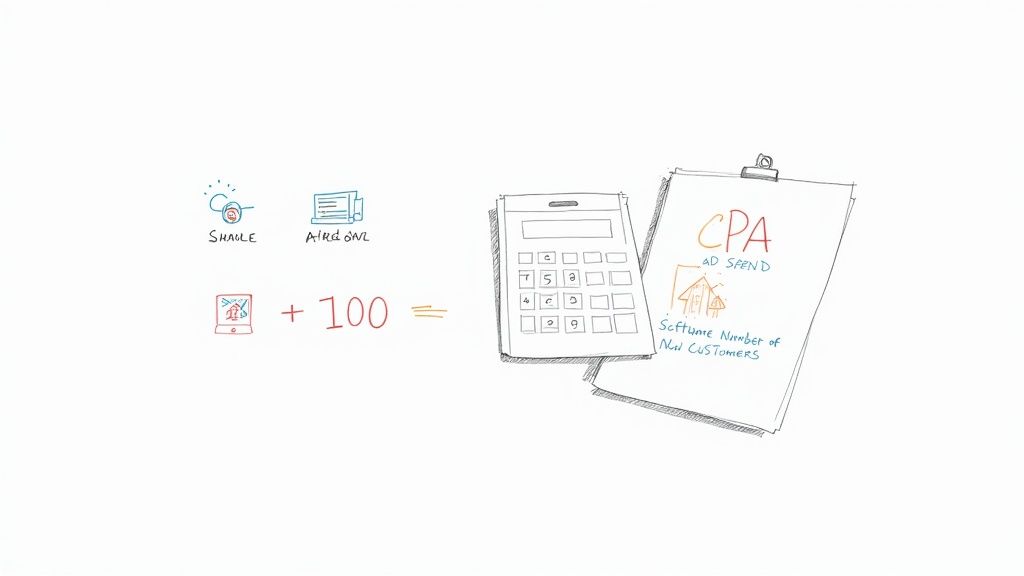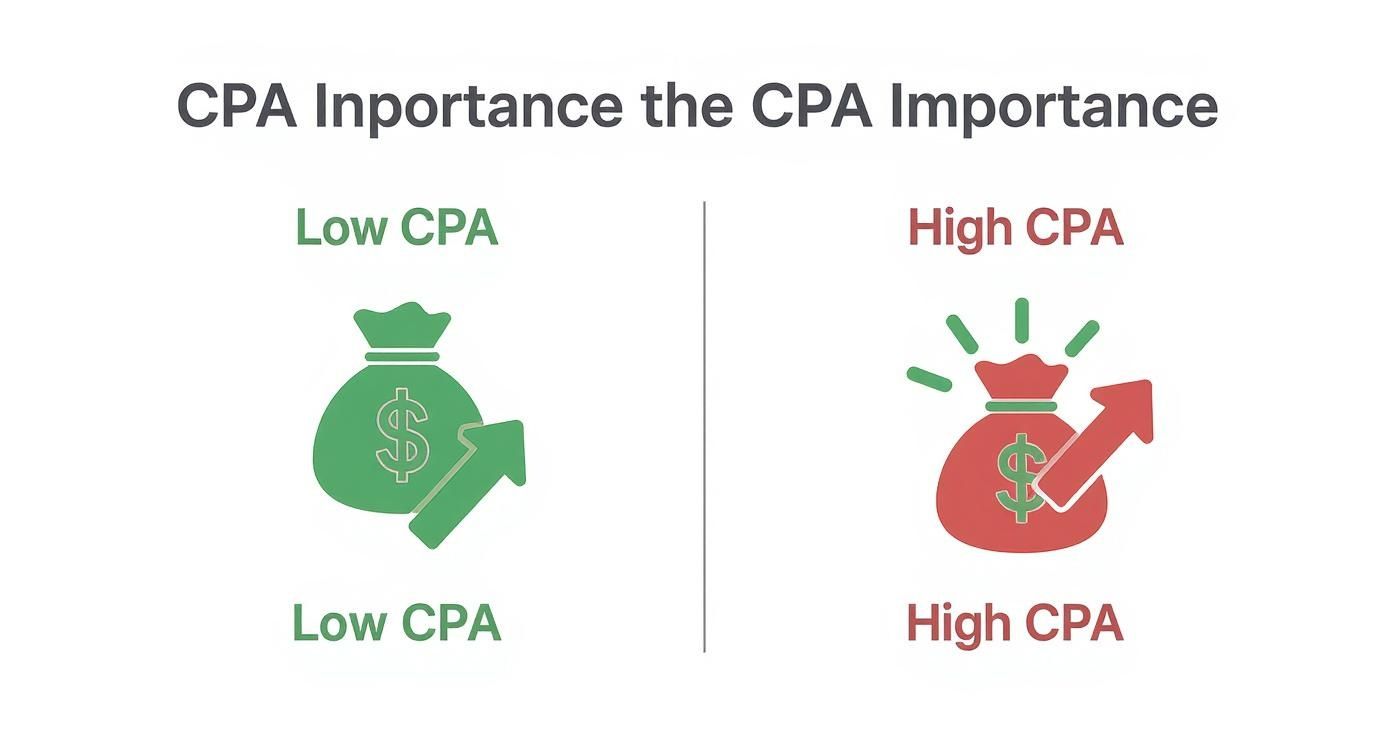
How to Improve Customer Engagement for SMBs
Discover how to improve customer engagement with practical strategies. Learn to personalize experiences, use AI, and build lasting customer loyalty.

In the world of marketing, there's one question that cuts through all the noise: How much does it really cost to get a new customer? That's exactly what Cost Per Acquisition (CPA) tells you.
Think of it as the final price tag for winning over a single paying customer through a specific marketing effort. If you pour $500 into a Facebook ad campaign and it brings in ten brand-new customers, your CPA is a straightforward $50. It’s the ultimate measure of how efficiently your marketing dollars are working.

Let's break it down with a simple analogy. Imagine you run a local bakery and decide to spend $200 on printing and distributing flyers for a new croissant special. If those flyers convince four people to come in and become regular customers, your Cost Per Acquisition is $50.
This single number strips away vanity metrics like "likes" or "impressions" and gets right to the heart of what drives your business forward: acquiring paying customers. Grasping this concept is the first step toward building a marketing machine that actually makes money.
To help clarify the moving parts, here’s a quick breakdown of what goes into calculating CPA.
As you can see, the formula is simple, but the insight it provides is incredibly powerful.
Keeping a close eye on your CPA is non-negotiable because it ties your marketing budget directly to real-world results. Without it, you’re flying blind. For a deeper dive, check out a comprehensive guide to Cost Per Acquisition that covers even more ground.
Here’s why CPA is so essential:

Figuring out your Cost Per Acquisition is straightforward. At its heart, the formula is simple, but it gives you a powerful number to judge how well your marketing is working.
CPA = Total Campaign Cost / Number of New Customers Acquired
This equation tells you precisely what it costs to get one new customer. The trick is in what you include in "Total Campaign Cost." It’s more than just what you paid for the ads.
To get a real, honest look at your CPA, you need to tally up all the expenses tied to a campaign. An accurate CPA reflects every dollar you invested to win over those new customers.
Think about including these costs:
Getting this number right is a critical piece of the puzzle you'll need when you measure your marketing ROI.
Let's walk through a quick example. Imagine an online store runs a Facebook ad campaign for a month.
Here's their breakdown:
So, for this campaign, it cost them $46 to acquire each new customer. Easy as that.
Think of your Cost Per Acquisition as your marketing campaign’s North Star. It’s a direct line of sight into whether your advertising is making you money or just burning through your budget.
A low CPA means your strategy is working efficiently. A high CPA is a red flag, signaling that it’s time to figure out what’s going wrong. This metric helps you funnel your dollars into the channels that deliver results and cut back on the ones that don’t.
The true power of CPA shines when you put it side-by-side with your Customer Lifetime Value (LTV). LTV is the total profit you can expect to make from a single customer throughout your entire relationship.
Comparing these two metrics tells you if you have a sustainable business. Are you spending $50 to acquire a customer who will only ever spend $40 with you? That’s a losing game.
A good rule of thumb is that your LTV should be at least 3x your CPA. This ratio (LTV:CAC) gives you enough breathing room to cover all your costs and still turn a healthy profit.
Ignoring your CPA is like driving blind. You're spending money, but you have no idea if you're headed toward profit or a dead end. It also ties directly into other critical metrics. For a clearer picture, use a return on ad spend calculator to see how CPA impacts your immediate returns.
So, you’ve calculated your CPA. Is it good? Is it bad?
The honest answer is: it depends. A $50 CPA might be a fantastic result for a high-end e-commerce store but a total disaster for a company selling mobile apps. Context is king.
You can't measure your success in a vacuum. Judging your CPA against some universal "average" is a recipe for frustration because it ignores your market, sales cycle, and customer value. This is why digging into industry-specific benchmarks is the first step toward setting goals that make sense for your business.
A business-to-business (B2B) company selling enterprise software will naturally have a much higher CPA than a direct-to-consumer (D2C) brand selling t-shirts. The B2B sale is a longer, more complex dance, so a higher initial investment is expected and necessary.
At its core, a low CPA is about efficiency—you're spending less to get more. A high CPA, on the other hand, is like a leak in your marketing budget.

This simple visual says it all. Driving your CPA down is what fuels a profitable, sustainable marketing engine.
The key takeaway is that success isn't about hitting a universal number but about achieving a profitable CPA within your specific market.
In the B2B space, these numbers can really get up there. The average B2B company might spend around $541.69 per acquisition. Dive deeper, and you'll find that financial services companies can pay close to $784 because of intense competition, while B2B software development hovers around $720.
You can explore more of these sector-specific acquisition costs to see how your industry compares. This data is crucial for knowing whether your marketing spend is smart.

Seeing a high Cost Per Acquisition shouldn't be cause for panic. Think of it as a signpost pointing you toward opportunities for improvement. Lowering your CPA is one of the fastest ways to make your marketing more profitable.
The path to a better CPA starts with getting specific. Instead of blasting your message to everyone, sharpen your audience targeting. Dig into your data, build detailed customer personas, and use platform tools to reach only the people most likely to buy. This stops you from wasting money on clicks that go nowhere.
It's no secret that getting new customers is harder than ever. Over the last ten years, the average Customer Acquisition Cost has shot up by about 222%. You can dive deeper into this trend and see how AI might help lower these costs on amraandelma.com.
Once you get the right people to click, the next challenge is to make the path to purchase as smooth as possible. A confusing or clunky experience will send potential customers running.
Here are a few high-impact tactics to focus on:
Controlling your bids is another huge piece of the puzzle. For a closer look, check out our guide on effective Google Ads bidding strategies to ensure you're getting maximum value from your ad spend.
Your Cost Per Acquisition doesn't live in a vacuum. It's constantly being nudged by big-picture forces like where you're advertising, who you're up against, and the state of the economy. Getting a handle on these outside pressures is key to setting a realistic budget and creating a marketing plan that can roll with the punches.
Things way outside your control can send your CPA soaring or sinking. Think about new data privacy rules that make it harder to target your ideal customer, or the mad dash for ad space during the holiday season that jacks up bidding costs for everyone.
A smart marketer knows that a winning strategy in one country could be a total flop in another. The trick is to read the market and tweak your approach to fit the unique challenges and openings each region presents.
Where you run your ads is just as important as what your ads say. A customer in a hyper-competitive, noisy market is almost always going to cost more to win over than one in a quieter, less crowded space.
This is especially true in eCommerce, where your physical location can have a huge impact on your Customer Acquisition Cost. In the United States, for instance, the average CAC for an online store sits between $68 and $78. But if you're a brand advertising on the West Coast, you can expect to pay 15–25% more because of fierce competition. Head to the Midwest, though, and you might see your costs drop by 10–20%.
It's a similar story in Europe. Germany's average CAC is about 30% higher than Spain's, which tells you a lot about how mature each market is. You can dig deeper into these numbers by checking out these eCommerce CAC benchmarks and their regional variations on loyaltylion.com.
This data means you need a smarter, location-specific strategy. When you understand these regional quirks, you can put your money where it will work hardest and set different CPA goals for different markets.
As we wrap up, let's tackle a few common questions that pop up when marketers first start getting serious about their Cost Per Acquisition.
It’s easy to mix these two up, but they tell very different stories.
Think of CPA (Cost Per Acquisition) as a micro-level metric. It’s focused on the cost of getting someone to take a specific action—like making a purchase or signing up—from a single campaign.
CAC (Customer Acquisition Cost), on the other hand, is the big picture. It rolls up all your sales and marketing expenses—from ad spend to team salaries and software—to tell you the total cost of landing one brand new customer for the entire business.
There's no single right answer—it really depends on what you're trying to learn.
For active digital campaigns, you should be peeking at your CPA daily or at least weekly. This helps you catch performance dips or spikes in real-time and make quick adjustments.
For a broader, strategic view of how your marketing channels are performing, a monthly or quarterly check-in is usually perfect. This cadence is great for spotting long-term trends and making bigger decisions about your budget.
Yes, absolutely! It might sound counterintuitive, but it can be a very smart and profitable move.
This often happens with subscription models or businesses where customers come back to buy again and again. The key is to look at the Customer Lifetime Value (LTV). If a customer's total spending over time is significantly higher than what you paid to get them, then a high initial CPA is just a smart investment in long-term profit.
Ready to stop guessing and start growing? BrandBooster.ai uses data-driven strategies to lower your CPA and maximize your return on ad spend. Learn how we guarantee results or you don't pay.